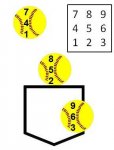I want to more actively teach this type of an approach, rather than just talk about it and hope hitters have some idea how to actually do it....so looking for coaching ideas/tips, etc...
- What is your philosophy of zone hitting? When necessary? HOW to execute it? vs. hard thrower? vs. change of speed pitcher? depending on count? etc? More than anything: how do you talk about it and explain it to your hitters so they *get* it?
- Talking about it is great, but how do you train/drill it? Any thoughts on using a pitching machine, using front-toss, even the tee to understand zones and start to understand how to execute a plan?
- What do you look for to improve in-game execution? Ie, what are some obvious fails/flaws in zone hitting, how do they show up in games, etc?
Any help appreciated. Assume high level pitcher/hitter, 16U/18U players....
TKS.
- What is your philosophy of zone hitting? When necessary? HOW to execute it? vs. hard thrower? vs. change of speed pitcher? depending on count? etc? More than anything: how do you talk about it and explain it to your hitters so they *get* it?
- Talking about it is great, but how do you train/drill it? Any thoughts on using a pitching machine, using front-toss, even the tee to understand zones and start to understand how to execute a plan?
- What do you look for to improve in-game execution? Ie, what are some obvious fails/flaws in zone hitting, how do they show up in games, etc?
Any help appreciated. Assume high level pitcher/hitter, 16U/18U players....
TKS.






